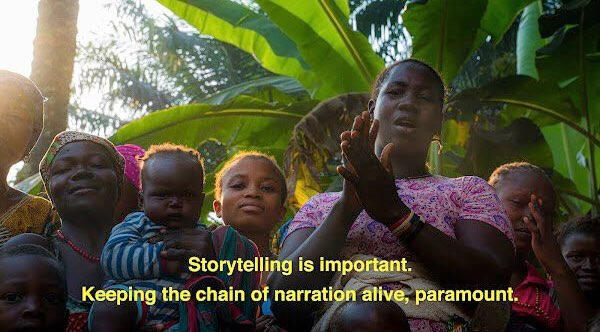My Cultural Preservation Project
The Tapestry

The Tapestry is a project leveraging blockchain technology, decentralized file storage, and metadata for cultural preservation.
Where it all began
Homecoming

In 2017, I saved up enough money to travel to Sierra Leone for the first time. Homecoming is a collection of visual stories illustrating my first visit to Sierra Leone, which felt very much like returning home.
Manifesto
We need transparent & accessible infrastructure, where we can share the value we create. Legacy social networks hold our audience and content hostage. We create the culture and it’s time to take it somewhere owned by all of us.
Only Legends
Community As
A Digital Asset
Don't Underestimate The Power Of Community
The Tapestry
The Tapestry is a project leveraging blockchain technology, decentralized file storage, and metadata for cultural preservation.In 2017 I traveled to my country of origin; Sierra Leone for the first time. 5 years later, funded by photography NFTs of that trip, I went back with the intent of exploring, documenting, and preserving my culture on the blockchain. 6 months and a near bout with death later, I am building:• A growing collection of poetry and song documented in short video format to be minted on the blockchain and funding further cultural preservation efforts in Sierra Leone, West Africa.•A front-end tool to help navigate, organize and connect a decentralized library of multimedia that is connected through strings of metadata.•A diverse community of storytellers and artists in Sierra Leone empowered by the Web3 ecosystemWhy “The Tapestry”?• The name is centered around the idea that the tapestry of culture and history is woven together with threads of poetry and song.• It is also a reference to the threads of metadata that can be woven together in a way that standardizes the way we put history on the blockchain and allows for the scalability of interconnected stories tied together through metadata itself.• There’s more to the name but we’ll connect those threads when we get there 🧵The Problem:• There are innovative technology solutions being built every day. But without the unique perspectives of people often the furthest removed from the technology, those who need it most access it the least, if ever at all. Although Diversity, equity, and inclusion are touted frequently in the Web3 space, there isn’t enough intentionality in making sure that underrepresented communities are at the forefront of innovation and that the tech serves our specific needs.• Although West Africans have a rich history of knowledge and culture that was transmitted in written format, much of our tradition has historically been transmitted orally. And with a lack of emphasis on the preservation of said oral stories, a lot of our most valuable tradition is at risk of dying out.• The traditional way of preserving knowledge and culture, be it written or oral, is centralized and often results in the loss of history. For example, due to the civil war that ravaged Sierra Leone from 1991-2002 many artifacts and archives were stolen and destroyed.• Modern-day attempts at storing data are inefficient and involve trusting large centralized entities with the storage and preservation of our most important information.• In the true spirit of decentralization we suffer from a lack of metadata standards which means we struggle to aggregate and organize related data although we are using such open and transparent technology.Problem Solving:• My work centers my people. As an immigrant Black Muslim community organizer of Sierra Leonean descent, I want to make sure that my work and Web3 serve my communities here in the U.S and also back home in Sierra Leone. A continued emphasis will be placed on access and onboarding of the communities I work with. Below are some photos from a Web3 onboarding effort I facilitated in Sierra Leone earlier this year. I was also interviewed about it by New Lines Magazinehttps://newlinesmag.com/reportage/the-new-frontier-african-artists-tap-into-a-digital-goldrush/• I have begun my effort to document and preserve oral histories in Sierra Leone. The goal is to build out a scalable digital library and archive of songs and poetry.• We need to forgo colonial and centralized ways of cultural preservation. I plan to lean into decentralized file storage by utilizing IPFS x File and make these digitized works widely accessible both in Sierra Leone (Where they are collected from) and internationally. Ideally, this project will be able to present a use-case for traditional entities to adopt innovative technologies and more inclusive practices.• Some of the songs will be turned into NFTS. 50% of the proceeds from The Tapestry will be allocated to continually funding cultural preservation. It will be a collaborative effort to breathe life into the storytelling traditions that are at risk of dying out by supporting the stewards financially while also onboarding more local Sierra Leoneans into Web3The Tool:Beyond being a story and archiving of songs and poetry,I want to build a tool other archivists, journalists, and storytellers can use to aggregate and filter metadata.The way I envision it is a front-end interface that utilizes an API like Zora Protocol to make a call for metadata from IPFS x Filecoin and allows users to interact and dynamically filter through the indexed metadata This tool will be able to bridge content on different blockchains and media that lives on Web3 with media that lives on Web3.As the first utilizer of the tool, I want to explore ways that storytellers can be transparent about the ways we influence the trajectory of a story using metadata.There were chiefs I worked with during my trip, whose relationships with me were bolstered by the fact that they knew my great grandfather.There are multiple instances where the young people in the villages did not know any old songs when I asked for them. In those moments I would witness them seek those songs out from their elders, learn them in real-time before they all sang them together in unison,I want to fashion the metadata aggregation tool in a way that allows for that kind of information to be embedded into the metadata as a way to enhance the storytelling and truthtelling of our projects.Where does The Tapestry cover?Songs and poetry are not just ways we connect cross-generationally but cross-culturally as well. The truth of the matter is that although my journey begins in Sierra Leone, I have already found threads which I intend to pursue that will take me to other countries including Brazil.Why Brazil?I train in the Afro-Brazilian martial art of Capoeria. Capoeira was invented and practiced by enslaved Africans in Brazil as a means of resistance. In order for them to train underneath the watchful eyes of their captors, the martial art was disguised within dance and performance.Music is a central part of the practice and as I began my training 3 years ago, I would hear within a particular song words that were said to be devoid of linguistic meaning but full of axé “Spiritual energy”However due to my proficiency in Arabic, and Islamic background, I heard linguistic meaning in this song whenever it was sung. Although slightly different, when I heard “Lalae, Lalae, Lalaela”, I heard dhikr which is Arabic for “Words of remembrance”Specifically, I recognized the testament of the Islamic faith in Arabic;” lā ʾilāha ʾillā -llāh” which can be translated as “There is no God but God”I was affirmed by this when I met my first Muslim Capoeira Mestre, Mestre Versatil.Unprompted, He sang the song the same way that I sang it and when I spoke to him, I learned that he also recognized the Arabic testament of faith within the songI was further affirmed by this during my recent trip to Sierra Leone where I found a village where the inhabitants sang lā ʾilāha ʾillā -llāh” in a way that had become slightly altered over time in a similar way.The difference is that in Sierra Leone the words still embodied the meaning while in Brazil the meaning is only partially preserved.I find this this to be one of the threads that connect West African Muslims who were enslaved in Brazil and West African muslims who never left the continent.So, my intention is to follow disconnected threads of connection wherever they take me and weave together the songs and poems that connect us around the world.



